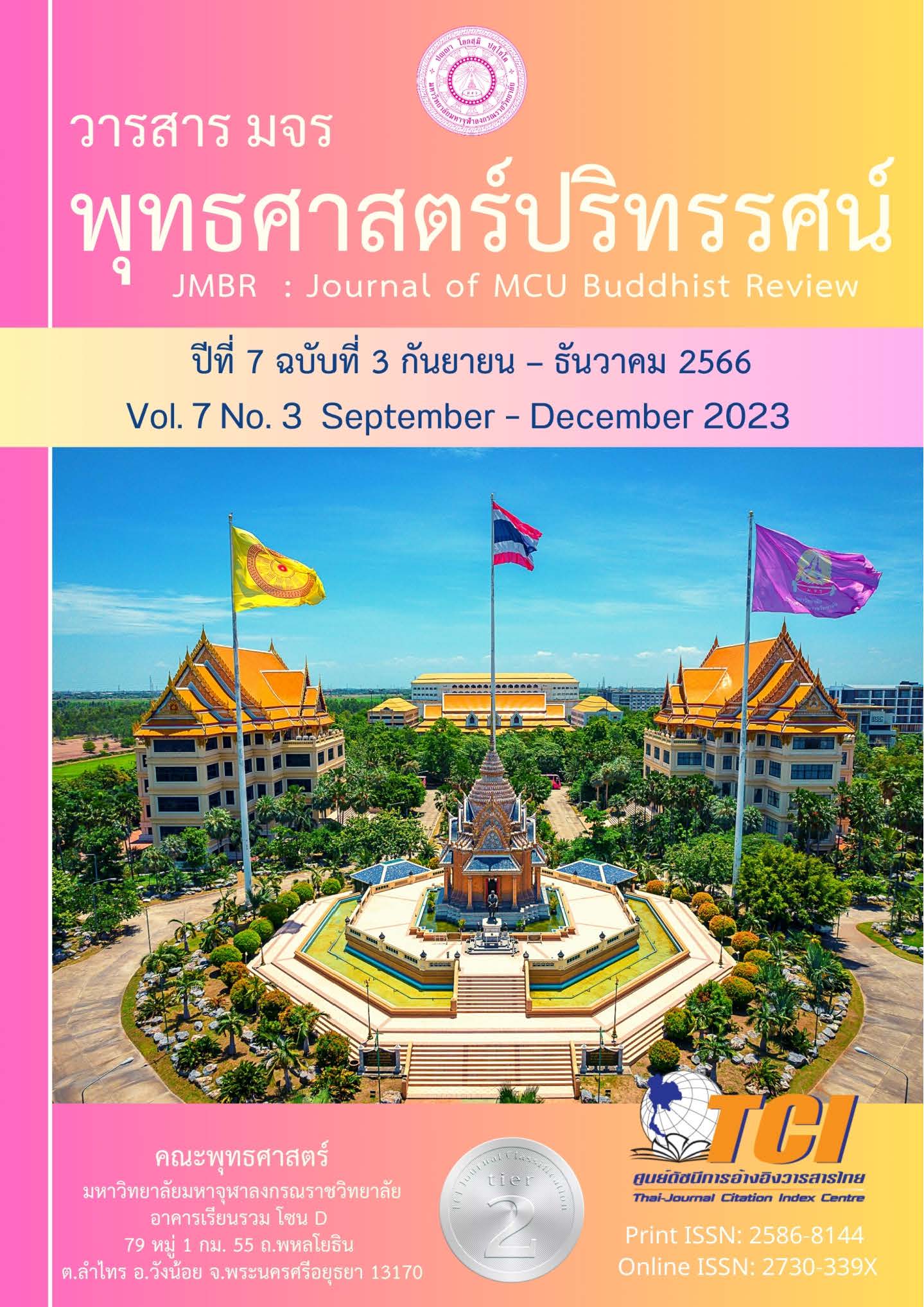เปรียบเทียบประเพณีอุ้มพระดำน้ำในศาสนาพุทธกับพิธีลอยพระพิฆเนศ วันคเณจตุรถีในศาสนาพราหมณ์-ฮินดู
Main Article Content
บทคัดย่อ
บทความวิจัยนี้มีวัตถุ 1) เพื่อศึกษาประเพณีอุ้มพระดำน้ำในศาสนาพุทธ 2) เพื่อศึกษาพิธีลอยพระพิฆเนศ วันคเณศจตุรถี ในศาสนาพราหมณ์-ฮินดู 3) เพื่อเปรียบเทียบประเพณีอุ้มพระดำน้ำในศาสนาพุทธ กับพิธีลอยพระพิฆเนศ วันคเณศจตุรถี ในศาสนาพราหมณ์-ฮินดู เป็นการวิจัยเชิงคุณภาพ การวิจัยนี้เป็นการวิจัยเชิงคุณภาพ โดยใช้วิธีการวิจัยเอกสาร และภาคสนามทำการสำรวจข้อมูลด้วยการสัมภาษณ์เชิงลึก กลุ่มประชากรผู้ให้ข้อมูล ได้แก่ ข้าราชการและคนพื้นที่ 10 คน นักวิชาการ 6 ท่าน ในพื้นที่อำเภอเมืองจังหวัดเพชรบูรณ์ การวิจัยนี้เป็นการวิจัยเชิงคุณภาพ วิเคราะห์และนำเสนอผลการวิจัยเชิงพรรณนา
ผลการวิจัยพบว่า 1) ประเพณีอุ้มพระดำน้ำเป็นประเพณีที่เกิดจากความเชื่อเกี่ยวกับพระพุทธรูปสำคัญคู่บ้านคู่เมืองประจำวัดไตรภูมิ คือ พระพุทธมหาธรรมราชา ดังนั้น ในเทศกาลทำบุญสารทไทยจึงมีพิธีอัญเชิญพระพุทธมหาธรรมราชาลงริ้วขบวนเรือไปสรงน้ำ มาทำพิธีที่ท่าน้ำของวัดโบสถ์ชนะมาร ชาวจังหวัดเพชรบูรณ์ได้ร่วมใจกันอัญเชิญพระพุทธมหาธรรมราชาเข้าพิธีดำน้ำ และสืบทอดประเพณีปฏิบัติต่อมาจนถึงปัจจุบัน 2) ประเพณีลอยพระพิฆเนศวันคเณจตุรถี ในศาสนาพราหมณ์-ฮินดู เป็นประเพณีที่ชาวฮินดูส่งองค์พระพิฆเนศกลับสู่วิมานเบื้องบน หลังพิธี สามวันโดยเชื่อว่า เป็นการอัญเชิญองค์พระพิฆเนศกลับสู่เขาไกรลาศ กลับสู่วิมานบน 3) เปรียบเทียบความเหมือนในมิติทางความเชื่อก่อให้เกิดผลดีต่อชีวิต เพื่อสร้างความสงบสุขแก่ตนเองและครอบครัว ส่งเสริมด้านการมีสัมมาคารวะ ที่สะท้อนถึงความอ่อนน้อมถ่อมตน เพิ่มความรักความสามัคคีแก่ชุมชน ให้คนรู้จักการเสียสละ ส่วนในประเด็นที่ต่างกัน พิธีอุ้มพระดำน้ำ เป็นขนบธรรมเนียมประเพณี ซึ่งมีรากฐานจากความเชื่อในศาสนา การประพฤติปฏิบัติตามจึงช่วยนำความสุขความเป็นสิริมงคลแก่ตนเองและครอบครัว ส่วนการบูชาพระพิฆเนศ โดยเชื่อว่าพระพิฆเนศเป็นเทพเจ้าแห่งความสำเร็จทั้งปวง มนุษย์สามารถขอในสิ่งที่ตนเองประสงค์ได้ ความแตกต่าง คือ กระบวนการ วิธีการ แต่สอดคล้องกันคือ การใช้สายน้ำเป็นตัวเชื่อมโยง ในพิธีกรรมนั้นๆ
Article Details

อนุญาตภายใต้เงื่อนไข Creative Commons Attribution-NonCommercial-NoDerivatives 4.0 International License.
- บทความที่ได้รับการตีพิมพ์เป็นลิขสิทธิ์ของวารสาร มจร พุทธศาสตร์ปริทรรศน์
- ข้อความใดๆ ที่ปรากฎในบทความที่ได้รับการตีพิมพ์ในวารสาร ถือเป็นความรับผิดชอบของผู้เขียนบทความ และข้อคิดเห็นนั้นไม่ถือว่าเป็นทัศนะและความรับผิดชอบของกองบรรณาธิการวารสาร มจร พุทธศาสตร์ปริทรรศน์
เอกสารอ้างอิง
แขขวัญ สุนทรศารทูล. (2554). สืบสานตำนานท้องถิ่น: ประเพณีอุ้มพระดำน้ำจังหวัดเพชรบูรณ์. เพชรบูรณ์: ม.ป.ท.
นุสรา จิตตเกษม. (2560). พระพิฆเนศ. วารสารวิชาการมนุษยศาสตร์และสังคมศาสตร์. 25(4), 137.
ป๊อก เชลซี. (2549). พระศรีคเณศมหาเทพแห่งความสำเร็จอันยิ่งใหญ่ ฉบับสมบูรณ์. กรุงเทพฯ: โรงพิมพ์ห้างหุ้นส่วนจำกัด เอส.พี.มิลเลี่ยนแนร์.
พระครูวินัยธรสุเทพ อกิญฺจโน (ทับทิมเทศ). (2539). การศึกษาเชิงวิเคราะห์เรื่องเทวดาในพระพุทธศาสนา เถรวาท. วิทยานิพนธ์พุทธศาสตร์มหาบัณฑิต บัณฑิตวิทยาลัย: มหาวิทยาลัยมหาจุฬาลงกรณราชวิทยาลัย.
พระใบฎีกาวีรศักดิ์ ธีรปญฺโญ (2554). ศึกษาประเพณีความเชื่อการอุ้มพระดำน้ำของชุมชนวัดไตรภูมิ อำเภอเมือง จังหวัดเพชรบูรณ์. วิทยานิพนธ์พุทธศาสตร์มหาบัณฑิต บัณฑิตวิทยาลัย: มหาวิทยาลัยมหาจุฬาลงกรณราชวิทยาลัย.
โสภนา ศรีจำปา. (2557). บทบาทศาสนาพราหมณ์-ฮินดู ซิกข์ เชนในการสร้างความเข้มแข็งให้กับครอบครัว สังคมวัฒนธรรมของชาวไทยเชื้อสายอินเดียในประเทศไทย. วารสารมหาวิทยาลัยศิลปากร. 35(1), 33-60.
เสกสรรค์ นิยมเพ็ง. (2565). นายกเทศมนตรีเมืองเพชรบูรณ์. สัมภาษณ์. 27 กันยายน.


